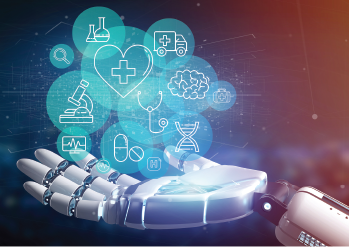A Tool Made for Pandemics

© Production Perig / shutterstock.com
This kind of diagnostic support is critical, particularly during pandemics such as COVID-19, noted Dr. Meyer, who’s also an associate professor of otolaryngology at UW.
Explore This Issue
November 2020“The pandemic wasn’t even a consideration when we started this process,” she said. “Before it hit, performing endoscopy to detect laryngeal abnormalities was a daily in-office procedure, just like listening to someone’s heart. But endoscopy has become a procedure that could be fraught with significant danger to the physician and the caregiving team. [That makes] the ability to actually acoustically follow, not the visual signal of the voice but the acoustic signal of the voice via telemedicine, very powerful.”
Refinements are still needed, Dr. Meyer acknowledged, but machine learning is far superior to previous methods for analyzing vocal disorders. “We have tons of acoustic and vocal tests, but none of them are very useful,” she said. “Whether it’s jitter, shimmer, or any other myriad artifacts we struggle with, none of it has panned out despite their continued use in the clinic [J Voice. 2017;31:382.e15-382.e26]. We’re very hopeful our approach will become that elusive, accurate vocal test with an actionable snapshot of the acoustic signature that can be followed very accurately over time, much like an EKG or a pulmonary function test. This kind of telemedicine-based approach will become critical during the continuing pandemic, where we just don’t have the same access to patients we’ve had in the past.”
Looking ahead, Dr. Bur said that machine learning has the potential to be a truly transformative technology in otolaryngology. But that trajectory depends in part on datasets. “The more data that you have, the more powerful these tools become,” he said. “If you think about an individual clinician who may treat a few thousand patients throughout their career, that’s one thing. But with machine learning, you can incorporate data from millions of patients in an algorithm. That opens up a whole new level of potential discernment, speed, and accuracy.”
Nikki Kean and David Bronstein are freelance medical writers based in New Jersey.
Parkinson’s Disease and Machine Learning
Outside of cancer, some promising work with machine learning in otolaryngology is being done in diagnosing dysphonia and other vocal abnormalities secondary to neurological conditions such as Parkinson’s disease (PD), said Andrés Bur, MD, an assistant professor and director of robotics and minimally invasive head and neck surgery at The University of Kansas (KU) Medical Center in Kansas City. “Researchers have made great progress using machine learning to analyze audio recordings of the voice,” he said. “It’s a natural fit, because the voice changes in PD are very characteristic. And while they might be somewhat easily identified by specialists, the primary care physician might not be so adept. Giving the non-specialist a tool to screen for voice changes that might signal PD is a real advance.”